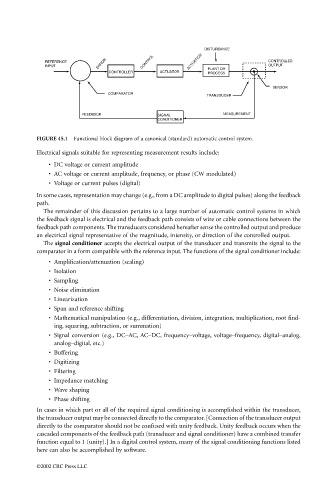Page 1162 - The Mechatronics Handbook
P. 1162
DISTURBANCE
ERROR
REFERENCE CONTROL ACTUATION CONTROLLED
INPUT PLANT OR OUTPUT
CONTROLLER ACTUATOR PROCESS
SENSOR
COMPARATOR
TRANSDUCER
FEEDBACK SIGNAL MEASUREMENT
CONDITIONER
FIGURE 45.1 Functional block diagram of a canonical (standard) automatic control system.
Electrical signals suitable for representing measurement results include:
• DC voltage or current amplitude
• AC voltage or current amplitude, frequency, or phase (CW modulated)
• Voltage or current pulses (digital)
In some cases, representation may change (e.g., from a DC amplitude to digital pulses) along the feedback
path.
The remainder of this discussion pertains to a large number of automatic control systems in which
the feedback signal is electrical and the feedback path consists of wire or cable connections between the
feedback path components. The transducers considered hereafter sense the controlled output and produce
an electrical signal representative of the magnitude, intensity, or direction of the controlled output.
The signal conditioner accepts the electrical output of the transducer and transmits the signal to the
comparator in a form compatible with the reference input. The functions of the signal conditioner include:
• Amplification/attenuation (scaling)
• Isolation
• Sampling
• Noise elimination
• Linearization
• Span and reference shifting
• Mathematical manipulation (e.g., differentiation, division, integration, multiplication, root find-
ing, squaring, subtraction, or summation)
• Signal conversion (e.g., DC–AC, AC–DC, frequency–voltage, voltage–frequency, digital–analog,
analog–digital, etc.)
• Buffering
• Digitizing
• Filtering
• Impedance matching
• Wave shaping
• Phase shifting
In cases in which part or all of the required signal conditioning is accomplished within the transducer,
the transducer output may be connected directly to the comparator. [Connection of the transducer output
directly to the comparator should not be confused with unity feedback. Unity feedback occurs when the
cascaded components of the feedback path (transducer and signal conditioner) have a combined transfer
function equal to 1 (unity).] In a digital control system, many of the signal conditioning functions listed
here can also be accomplished by software.
©2002 CRC Press LLC

